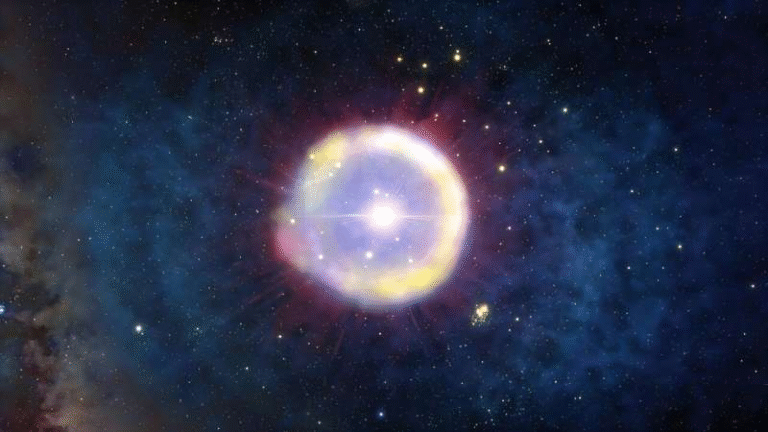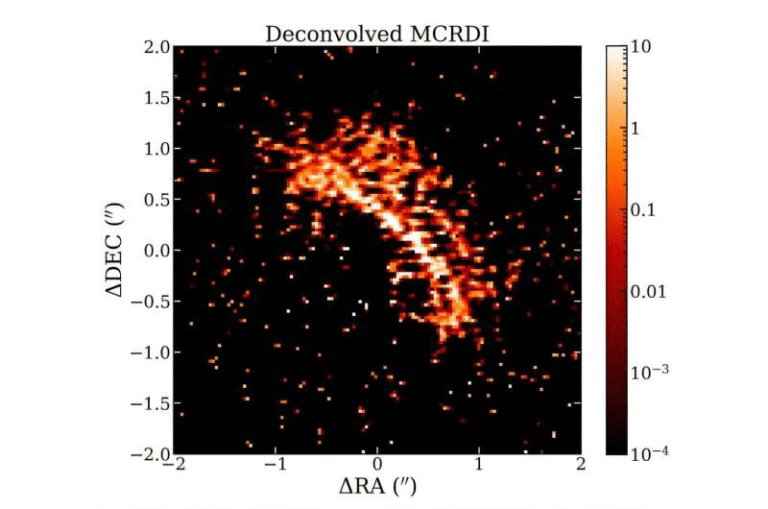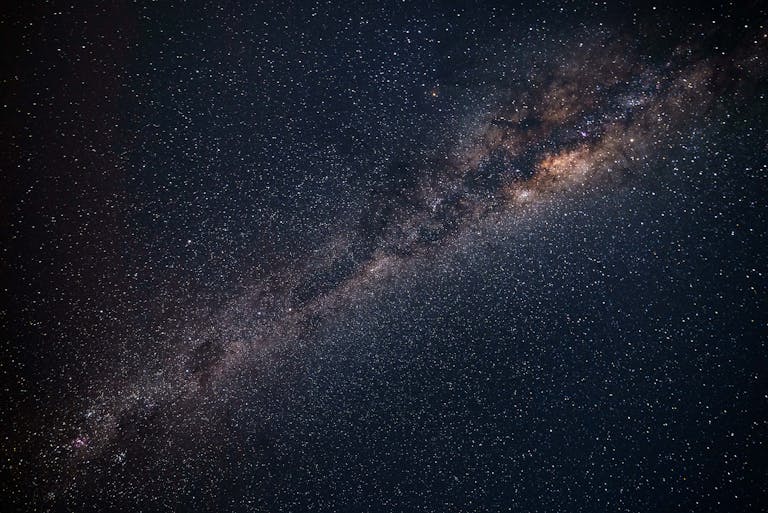A New Look at Galaxy OJ 287 Reveals a Strange Ribbon-Like Plasma Jet

The galaxy OJ 287, located around five billion light-years away from Earth, has intrigued astronomers for more than a century. Known for its unusual changes in brightness and dramatic bursts of energy, it has long been suspected to harbor two supermassive black holes locked in a cosmic dance at its core. Now, a groundbreaking observation has unveiled something extraordinary: a sharply curved, ribbon-like plasma jet streaming from its center, unlike anything seen before.
This new finding, led by Dr. Efthalia Traianou of Heidelberg University, sheds fresh light on how extreme environments around black holes behave and evolve. Let’s go through the specifics of this discovery in detail, and then explore some background information on what makes OJ 287 — and plasma jets in general — so fascinating.
What Exactly Was Found
Astronomers managed to capture one of the most detailed images ever of OJ 287’s core. Using a unique combination of space and ground-based radio telescopes, the team created a virtual telescope five times wider than Earth itself. This setup made it possible to peer deep into the galaxy’s heart and capture the jet of plasma erupting from its central black holes.
What stood out immediately in the image was the sharp bend in the jet, forming a ribbon-like structure that challenges previous assumptions about how plasma jets are launched and shaped. Normally, jets are thought to flow out in relatively straight or smoothly curving paths. This one looked twisted, warped, and bent.
The new observations also revealed regions inside the jet that exceed temperatures of ten trillion degrees Kelvin — evidence of unimaginable energy and particle acceleration occurring close to the black hole. For context, the core of the Sun is only about 15 million Kelvin, which makes this plasma environment almost beyond comprehension in terms of heat and radiation.
Another key detail was the detection of a new shock wave forming, spreading, and colliding within the jet. Researchers believe this is tied to an unusual gamma-ray measurement recorded back in 2017, in the trillion-electron volt energy range. That event hinted at something extreme happening near the black hole, and now scientists have visual evidence of how such high-energy disturbances might ripple through the jet.
How Did They Do It?
The technical side of this discovery is impressive in its own right. The team used a space-ground radio interferometer consisting of:
- The RadioAstron mission’s ten-meter-long antenna on board the Spektr-R satellite orbiting Earth.
- A network of 27 ground-based radio observatories spread across the globe.
By combining their signals, astronomers essentially built a virtual telescope with a resolution far surpassing any single instrument. The technique relies on the wave nature of light and the principle of overlapping waves — allowing researchers to measure incredibly fine details.
The result was an image with unprecedented sharpness in the radio spectrum, letting scientists zoom into the galaxy’s innermost regions where the black holes and their jets reside.
Why OJ 287 Is Special
OJ 287 isn’t just any active galaxy. It belongs to a class known as blazars. These are galaxies with supermassive black holes at their centers, actively pulling in material. Instead of swallowing all of it, the black hole’s environment funnels some of the matter and energy outward at nearly the speed of light, creating plasma jets.
What makes OJ 287 unusual is the periodic outbursts in brightness that have been observed for well over a century. These changes are so consistent that many astronomers believe they are caused by two supermassive black holes orbiting each other. As the smaller one passes through the accretion disk of the larger one, it may disturb matter and trigger flares.
This binary black hole system also makes OJ 287 a prime candidate for studying gravitational waves. The orbiting giants would produce ripples in spacetime, detectable by specialized observatories in the future.
Extreme Energy at the Galactic Core
One of the remarkable aspects of this discovery is the scale of energy involved. The plasma jet contains radiation, highly energetic particles, and powerful magnetic fields. The sheer brightness and heat are clear signs of relativistic effects, meaning particles are moving close to the speed of light.
The detected shock wave inside the jet demonstrates how chaotic and violent this environment can be. Shock waves in plasma jets can occur when bursts of energy collide with slower-moving material. These shocks accelerate particles to extreme energies, producing the kind of gamma rays and X-rays that make blazars shine so brightly.
The Binary Black Hole Connection
The curved jet structure seen in OJ 287 is more than just a visual curiosity. It strongly supports the idea that a binary supermassive black hole system sits at its center. If two black holes are indeed orbiting each other, their movement would exert a gravitational influence on the jet, bending and twisting its path.
This observation provides critical evidence for theories that have been circulating for decades. It also means that OJ 287 could help scientists learn how merging black holes affect their surroundings, and how those interactions might eventually lead to the emission of gravitational waves.
Why This Matters for Astronomy
The findings from OJ 287 don’t just add a new wrinkle to our understanding of one galaxy — they offer insights into the broader picture of how galaxies evolve. Supermassive black holes are believed to play a central role in galaxy formation and growth. Their jets can regulate star formation by either blasting material out of the galaxy or compressing clouds to trigger new stars.
By studying OJ 287, astronomers can get a clearer idea of how merging black holes influence these processes. The curved, ribbon-like jet is essentially a natural laboratory for testing ideas about black hole physics, relativistic jets, and the interplay of magnetic fields at cosmic scales.
A Closer Look at Plasma Jets
Since this discovery revolves around plasma jets, let’s expand a bit on what they are.
- Plasma is often called the fourth state of matter, consisting of charged particles — electrons and ions — that behave differently from gases, liquids, or solids.
- In the context of black holes, plasma is created in the accretion disk, where infalling matter heats up to extreme temperatures and becomes ionized.
- Some of this plasma is then funneled along the black hole’s magnetic field lines and expelled outward at nearly light speed.
- These jets can extend for hundreds of thousands of light years, impacting not just the host galaxy but also the intergalactic medium.
OJ 287’s plasma jet is now one of the best-studied examples, especially given the new detail captured in this latest observation.
The Technology Behind the Discovery
The observational method used here — very long baseline interferometry (VLBI) — is a powerful technique in radio astronomy. By placing telescopes very far apart and combining their signals, astronomers achieve the effect of a telescope as large as the distance between them.
Adding a telescope in space (like the Spektr-R satellite) greatly increases the “baseline,” boosting resolution to unprecedented levels. Without this approach, the intricate ribbon-like features of OJ 287’s jet would have remained invisible.
The Road Ahead
This discovery sets the stage for even more detailed studies. Since OJ 287 is one of the best candidates for merging supermassive black holes, continued monitoring could reveal new changes in the jet or additional shock waves tied to energetic events.
Future instruments, such as the Square Kilometre Array (SKA) and space-based gravitational wave observatories, will provide even deeper insights into systems like OJ 287. With its peculiar brightness variations, gamma-ray outbursts, and now its strangely curved plasma jet, this galaxy will remain a prime target for astrophysicists trying to understand some of the most extreme physics in the universe.
Final Thoughts
The new image of OJ 287 represents more than just a snapshot of a distant galaxy. It captures a dynamic, evolving system where gravity, magnetism, and energy collide at unimaginable scales. From the discovery of its twisted plasma jet to the confirmation that two supermassive black holes are shaping its heart, OJ 287 continues to be one of the most fascinating laboratories in the cosmos.
This isn’t just about one galaxy far away — it’s about unlocking the secrets of how black holes shape the universe itself.
Research Reference: Revealing a ribbon-like jet in OJ 287 with RadioAstron (Traianou et al., Astronomy & Astrophysics, 2025)





